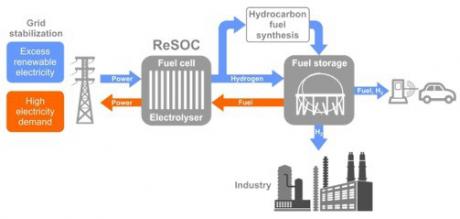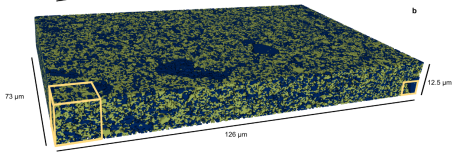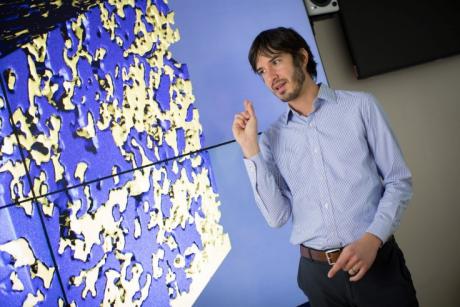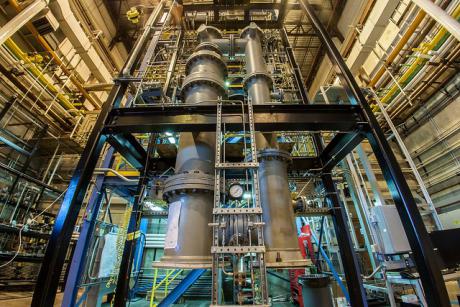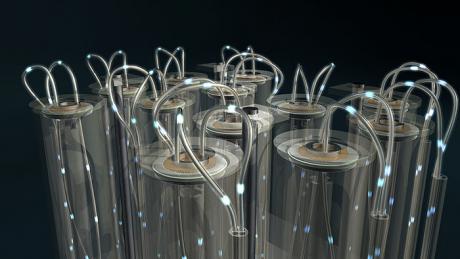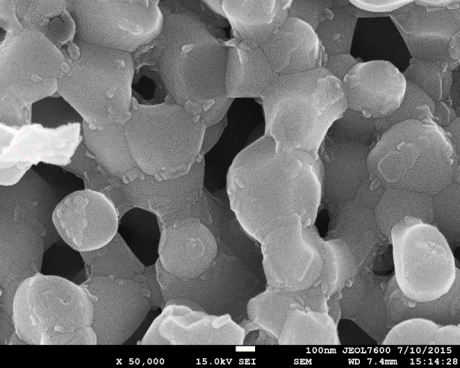NETL’s work with solid oxide fuel cells is enhancing the nation’s electric grid by generating combustion-free power with minimal environmental impact. The Lab is now extending its research vision to develop reversible solid oxide cells, which can alternately either generate power or produce clean-burning fuel.
NETL researchers are exploring how heterogeneity, or a lack of uniform structure and composition, on a microscopic level can affect the performance of solid oxide fuel cell (SOFC) components. SOFCs, which, like batteries, create electricity directly through electrochemical reactions, are extremely efficient, require minimal water consumption and generate almost no emissions; however, SOFCs face issues with reliability, durability and cost.
NETL researchers are using the Lab’s cutting-edge computational tools to model thousands of simulated microstructures as they seek to boost the performance and longevity of energy-efficient, near-zero-emission solid oxide fuel cells (SOFCs).
ClearPath Foundation, a non-profit organization that specializes in developing policies and research that supports clean energy initiatives through small government, free markets, and American innovation will visit NETL in Morgantown, West Virginia, Tuesday, Dec. 4 to learn about the Laboratory’s work on carbon capture and storage, solid oxide fuel cells, systems engineering analysis, chemical looping, and hybrid performance – technology research areas with potential for advancing clean energy innovations.
The U.S. Department of Energy’s (DOE) Office of Fossil Energy (FE) has selected 16 projects to receive approximately $13.5 million in federal funding for cost-shared research and development (R&D) projects that will advance solid oxide fuel cell (SOFC) technologies.
The U.S. Department of Energy (DOE) has announced up to $32.5 million in federal funding for cost-shared research and development (R&D) to advance solid oxide fuel cell technologies (SOFC). The selected projects will fall under the Office of Fossil Energy’s two funding opportunity announcements (FOAs):Preliminary Design and Techno-Economic Analysis of MWe-Class Solid Oxide Fuel Cell Systems and Solid Oxide Fuel Cells Core Technology Research.
The U.S. Department of Energy’s (DOE) Office of Fossil Energy (FE) has selected two projects to receive approximately $2.8 million in federal funding for cost-shared research and development projects. The projects will advance solid oxide fuel cell (SOFC) technology and make progress toward enabling cost-competitive fossil-based power generation with near-zero emission. Fuel cells are a modular, efficient, and virtually pollution-free power generation technology.
The U.S. Department of Energy’s (DOE’s) Office of Fossil Energy (FE) has selected 16 projects to receive $10.2 million in funding to advance solid oxide fuel cell (SOFC) technology.
The new projects were selected under funding opportunity announcement DE-FOA-000 1735, Solid Oxide Fuel Cell Prototype System Testing and Core Technology Development, which supports development of reliable and robust SOFC technology for first-of-a-kind fuel cell systems.
Fuel cell technology is a unique form of energy creation—an efficient, quiet, and clean method of transforming an energy source (such as propane, diesel, or natural gas) into electricity.
Traditional fossil-fuel power generation technology produce energy through combustion—harnessing the energy of a chemical reaction to power the mechanical processes that produce electricity. This is often a noisy process, and produces exhausts and toxic fumes that must be carefully contained.
Solid oxide fuel cells (SOFCs), a promising technology that can efficiently produce energy using fossil fuels with no moving parts and low emissions, present a particularly perplexing economic challenge: current systems operate at maximum efficiency between 700 and 1000 degrees Celsius, but such high temperatures shorten their service life, requiring more frequent fuel cell stack replacements. Lowering the operating temperature makes them last longer, but requires additional cells in the stack to deliver the same performance, and that drives up costs.




